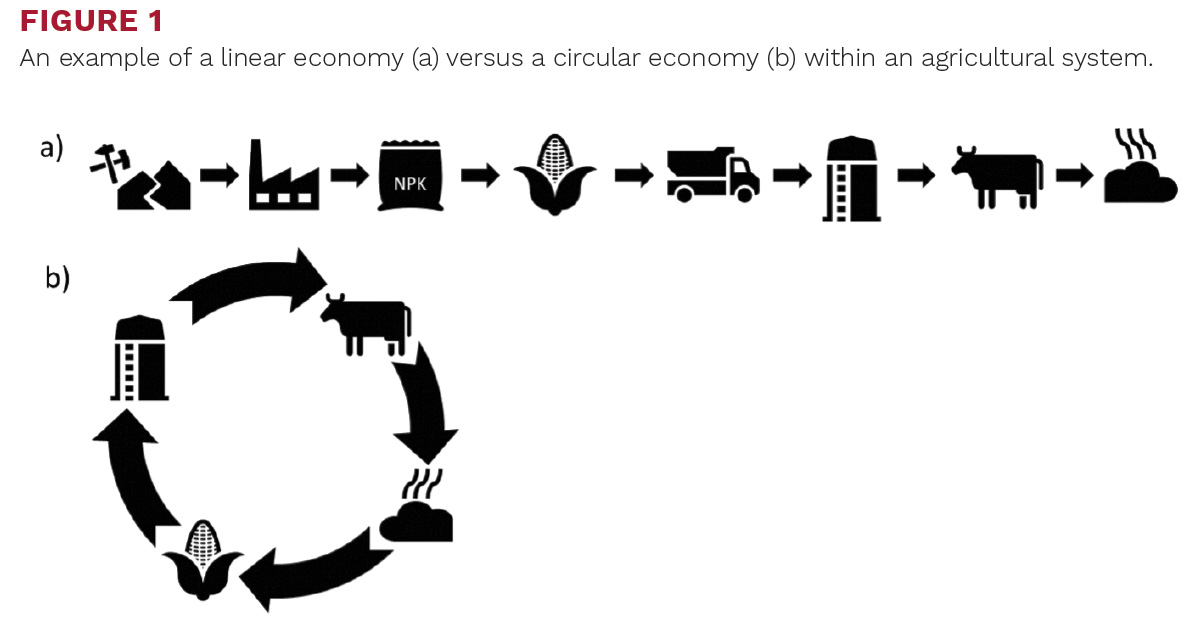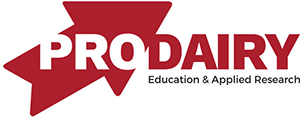It is well-established that the dairy sector provides essential livelihoods and vital nutrition to billions of people, and that the dairy sector is dedicated to addressing sustainability challenges. Current conversations about dairy sustainability include terms like circularity, regenerative agriculture, and carbon footprint. What is that all about?
WHAT IS A CIRCULAR ECONOMY?
Traditionally economies are linear, starting with raw materials that are made into products that are used and eventually become part of a waste stream. In a circular economy, one looks at the bigger picture, takes into account the whole system, and tries to form a closed loop, keeping materials, products, and services in circulation for as long possible. A circular economy is based on three main principles: to eliminate waste and pollution, to circulate products and materials, and to regenerate nature. This concept strives to reduce environmental impact, while improving financial and social aspects of production, including agricultural production.
One illustration of a linear versus circular economy within an agricultural system is the application of nutrients. A linear example is applying fertilizers mined from the earth or manufactured through industrial processes to crops that feed animals and produce manure that is not recycled back onto the cropland. In comparison, use of livestock manure to fertilize crops that are fed to livestock and produce more manure to apply to cropland and continue the cycle are a circular economy. (FIGURE 1)

Dairy farms can have various degrees of circularity, often influenced by their location and availability of local resources, including manure, land for feed production, climate, water availability, contractors, and equipment. Farm management and decisions on how to use these resources can also greatly influence the degree of circularity on a dairy farm.
SUSTAINABILITY BENEFITS OF A CIRCULAR ECONOMY
Circular economies are strongly encouraged in all industries because of their sustainability benefits. A circular economy can help lower greenhouse gas (GHG) emissions through shorter supply chains, reduced transport needs for inputs and waste materials, reduced processing needs and use of energy, fuel and other raw material, and reduced use of end-life of products.
In dairy systems, many of the beneficial and protective management practices adopted by farmers already reflect principles of a circular economy and improved sustainability. This includes practices such as use of cover crops and subsequent reductions in nitrogen fertilizer use, injection of manure to capture more of its nutrients, and reducing tillage intensity to protect soil and soil carbon. Positive results of these efforts are seen in water quality, soil carbon sequestration, and overall resilience of the agriculture system and nature. Further, good management of feed storage on farm to avoid waste through spoilage and feed refusals, and animal husbandry practices that promote good animal health and welfare to reduce the need for veterinary inputs, milk disposal and animal culls, all follow the principles of a circular economy.
HOW CIRCULAR IS THE NORTHEAST DAIRY INDUSTRY?
The Northeast region of the U.S. has a high potential to achieve an advanced circular economy. Why?
The dairy industry in the Northeast takes advantage of a local climate that allows for production of high-quality forages with natural rainfall, resulting in production of significant amounts of home-grown feed for dairy cattle. A recent assessment of whole-farm nutrient mass balances of dairies in the Northeast showed that 70 percent of the feed fed on the dairy farms that completed the assessment between 2016 and 2018 (Ros et al., 2023) was homegrown, and almost all this feed was forages such as corn silage, alfalfa, and grass.
The land base associated with dairy farms in the Northeast allows for a relatively low number of animals per acre of land (animal density), and that ensures the ability to recycle the nutrients excreted by the manure of these animals both locally and responsibly.
This integration of animal and crop production has multiple benefits. A most relevant benefit to a circular economy is reduced reliance on synthetic fertilizers. This integration helped dairy farms in the Northeast who conducted whole farm nutrient mass balance assessments between 2016 and 2018 to achieve fertilizer application rates that averaged just 3.8 lbs. per acre for phosphorus, and 57 lbs. per acre for nitrogen (Ros et al., 2023). In disconnected animal and crop regions, the principles of a circular economy are much more difficult to achieve.
Despite producing most of their feed at home, dairy farmers in the Northeast still need to import some feed, mainly protein and energy sources to balance cow diets, and optimize cow health, efficiency, and milk production. Yet, there is a tendency for farmers to source these products regionally where possible. There are several examples of successful relationships between dairy farmers and corn grain and soybean growers in the Northeast, which allows for local sourcing of cornmeal, soybean meal, and other feedstuffs in addition to local recycling of manure nutrients. While the incentive behind these practices make sense financially, they also follow the principles of a circular economy, benefitting the circularity and sustainability of both the dairy industry, and the related industries.
In addition to utilizing locally produced feedstuff, many dairies in the Northeast utilize both waste and by-products from other local industries such as whey, distillers’ and brewers’ grains, oilseed meals, candy and bakery waste, and others. This too contributes directly to the circular economy, by avoiding the landfilling of products that can be converted to milk by cows.
Efficient use of equipment is important in a circular economy as well. It is now becoming increasingly popular for farmers to make use of contracting companies for the field activities associated with homegrown feed production (such as manure spreading, planting, and harvest), in contrast to every farmer purchasing their own machinery for every task. This reduces the amount of raw materials required to build and maintain equipment and the amount of equipment that needs to be disposed when it reaches the end of its useful life, again following the principles of a circular economy. Farmers who do choose to purchase and operate their own machinery can still contribute to a circular economy by maximizing efficiency of production and acquiring the most suitable equipment for their operations.
Dairy farmers can and are following the principles of a circular economy and promoting sustainability of the dairy industry for their region. Many of these practices have the potential to not only reduce the environmental impact of dairy production, but also improve financial and social aspects on individual farms, and across the region.
What can you do to promote a circular economy and sustainability on your farm?
- Maximize homegrown feed and high-quality forage production and storage.
- Capitalize on the nutrient and biological value of manure.
- Utilize locally available resources, including waste and by-products for both feed and energy production (anaerobic digestion).
- Establish relationships with neighbors for feed imports and manure exports.
- Adopt beneficial and protective crop management practices, such as cover crops, manure injection and reduced tillage to protect soil, water, and air quality.
 |
This article appeared in PRO-DAIRY's The Manager in March 2023. To learn more about Cornell CALS PRO-DAIRY, visit PRO-DAIRY. |




